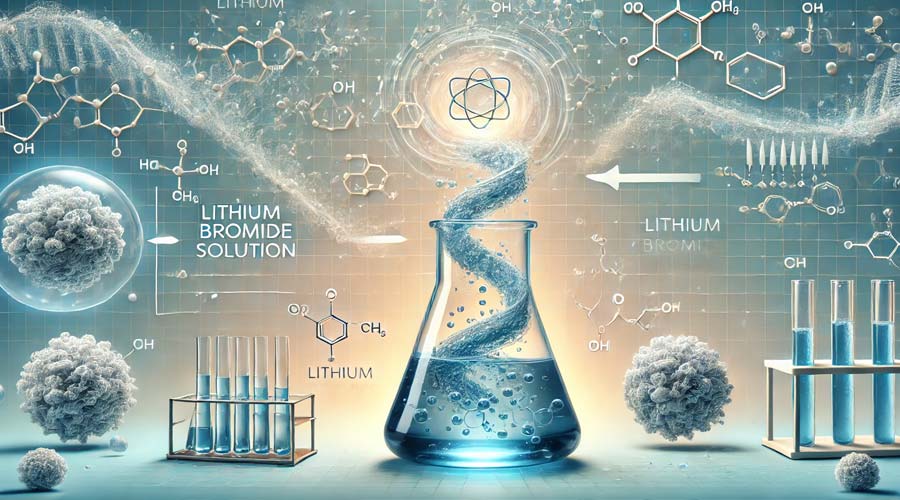In the realm of materials science and green chemistry, the Lithium Bromide Solution ability to effectively dissolve and regenerate cellulose is of immense significance. Cellulose, a natural polymer found in the cell walls of plants, is abundant and biodegradable, making it a sustainable resource for various applications. However, its rigid structure and insolubility in water present challenges when attempting to process it. Enter lithium bromide solution—a powerful solvent that can dissolve cellulose and regenerate it into a versatile gel. This article explores the science behind this process, its applications, and the potential it holds for sustainable development.
Table of Contents
1. Introduction to Cellulose and Its Challenges
Cellulose is the most common organic polymer on Earth, composed of glucose units linked by β(1→4) glycosidic bonds. Despite its abundance, cellulose’s crystalline structure and extensive hydrogen bonding make it difficult to dissolve in most solvents. This characteristic has long limited its direct use in various industries. However, the discovery that lithium bromide (LiBr) in concentrated aqueous solutions can dissolve cellulose has opened new avenues for its processing and application.
2. The Role of Lithium Bromide Solution in Dissolving Cellulose
Lithium bromide solution stands out as one of the few solvents capable of breaking down the rigid structure of cellulose. The high concentration of LiBr in water disrupts the hydrogen bonds between cellulose chains, allowing the polymer to dissolve. This process not only facilitates the dissolution of cellulose but also enables its subsequent regeneration into a gel form, which can be molded or processed further.
Key Mechanism:
- Hydrogen Bond Disruption: Lithium bromide ions interfere with the hydrogen bonds in cellulose, effectively separating the chains and leading to dissolution.
- Gel Formation: Upon removal of the solvent, the dissolved cellulose can be regenerated into a gel, retaining its polymeric properties while adopting a new, versatile form.
3. Applications of Cellulose Gel Formed Using Lithium Bromide Solution
The ability to dissolve and regenerate cellulose into a gel form has significant implications across various industries:
- Textiles and Fibers: Cellulose gel can be spun into fibers for use in sustainable textiles, offering an eco-friendly alternative to synthetic fibers.
- Biomedicine: Regenerated cellulose gels are used to create hydrogels, which have applications in wound dressing, drug delivery, and tissue engineering.
- Food Industry: Cellulose gel serves as a thickening agent and stabilizer in various food products, providing texture and consistency.
For a closer look at lithium bromide products, visit our Lithium Bromide Products page.
4. The Environmental Impact and Sustainability of Using Lithium Bromide
The use of lithium bromide solution to dissolve cellulose aligns with the principles of green chemistry. Unlike other solvents that may be toxic or difficult to recover, lithium bromide is relatively benign and can be efficiently recycled. This makes the process not only effective but also environmentally responsible.
Sustainability Benefits:
- Resource Efficiency: Cellulose is a renewable resource, and its conversion into gel form via lithium bromide promotes sustainable material use.
- Reduced Waste: The ability to recycle lithium bromide and regenerate cellulose minimizes waste, contributing to a circular economy.
- Eco-friendly Alternatives: The process offers an alternative to petroleum-based products, reducing dependence on non-renewable resources.
5. Future Prospects for Lithium Bromide in Cellulose Processing
The potential applications of cellulose gel produced using lithium bromide solution are vast and expanding. Research is ongoing into optimizing the dissolution process and exploring new uses for cellulose gels. From biodegradable packaging materials to advanced composites, the future of lithium bromide in cellulose processing holds great promise for innovation in sustainable materials.
6. Frequently Asked Questions (FAQs)
Q1: How does lithium bromide dissolve cellulose?
A1: Lithium bromide disrupts the hydrogen bonds in cellulose, allowing the rigid polymer to dissolve in solution.
Q2: What are the primary applications of cellulose gel?
A2: Cellulose gel is used in textiles, biomedicine, and the food industry, where it serves as fibers, hydrogels, and thickening agents, respectively.
Q3: Is the use of lithium bromide solution environmentally friendly?
A3: Yes, lithium bromide is relatively benign and can be recycled, making it an environmentally responsible choice for dissolving cellulose.
Q4: Can cellulose gel be used in biodegradable materials?
A4: Absolutely. Cellulose gel offers a sustainable alternative for creating biodegradable packaging and other eco-friendly materials.
Q5: What future developments can we expect in cellulose processing using lithium bromide?
A5: Ongoing research is likely to expand the applications of cellulose gel, particularly in sustainable materials and advanced composites.
7. Conclusion
The use of lithium bromide solution to dissolve and regenerate cellulose into gel represents a breakthrough in sustainable material processing. By leveraging this powerful solvent, industries can unlock the full potential of cellulose, transforming it into a versatile and eco-friendly material. As the world continues to seek greener alternatives, the role of lithium bromide in cellulose processing is poised to grow, paving the way for innovative applications and a more sustainable future.
For more information about lithium bromide and its uses in cellulose processing, explore our Lithium Bromide Products page or contact Honrel Company for tailored solutions.









